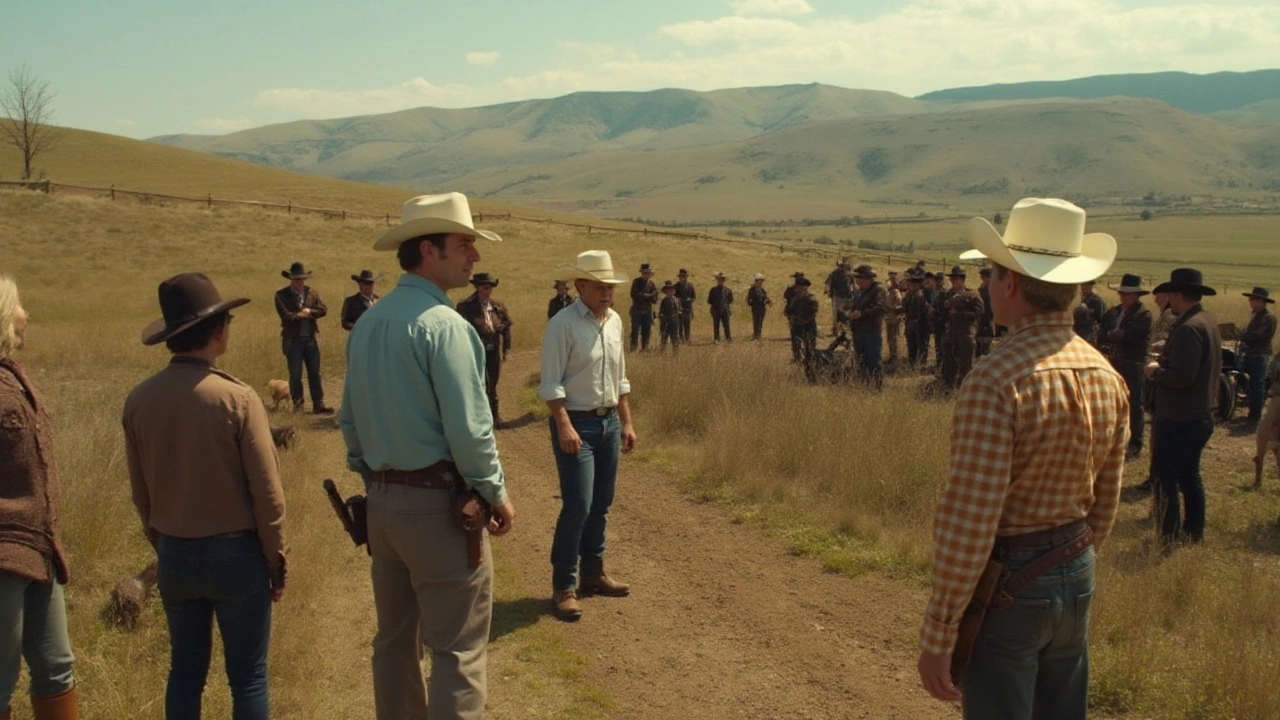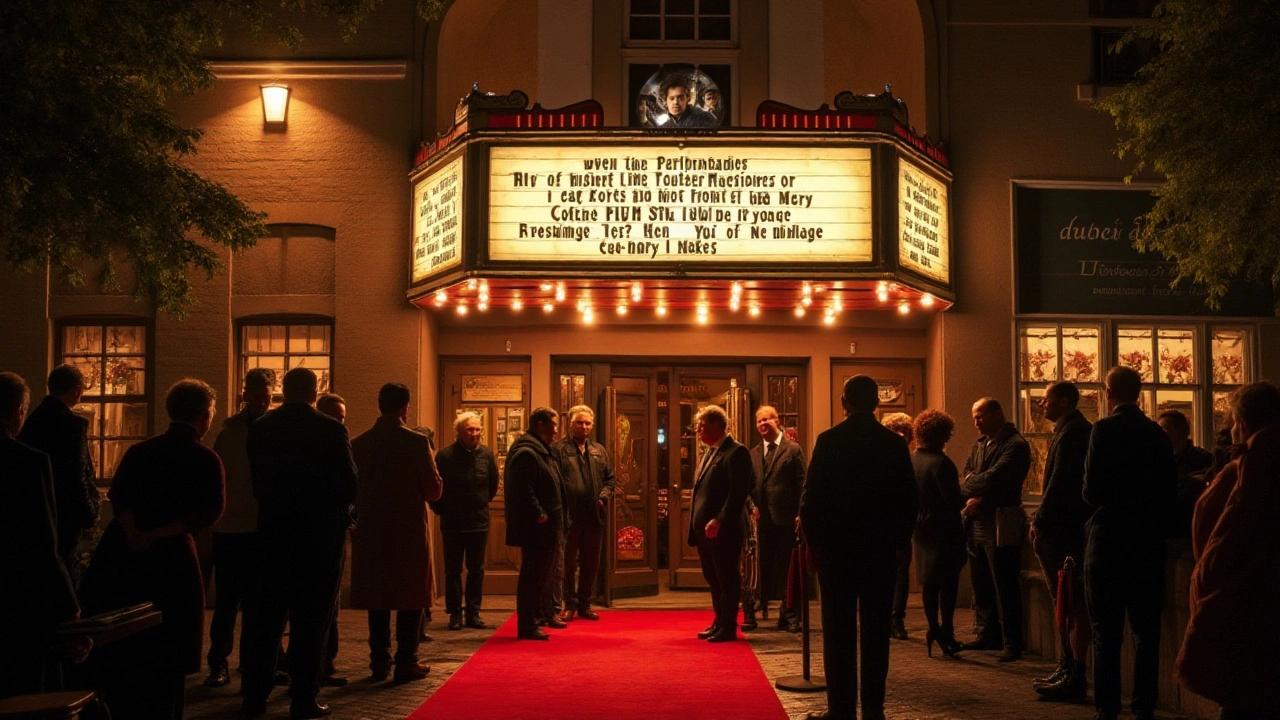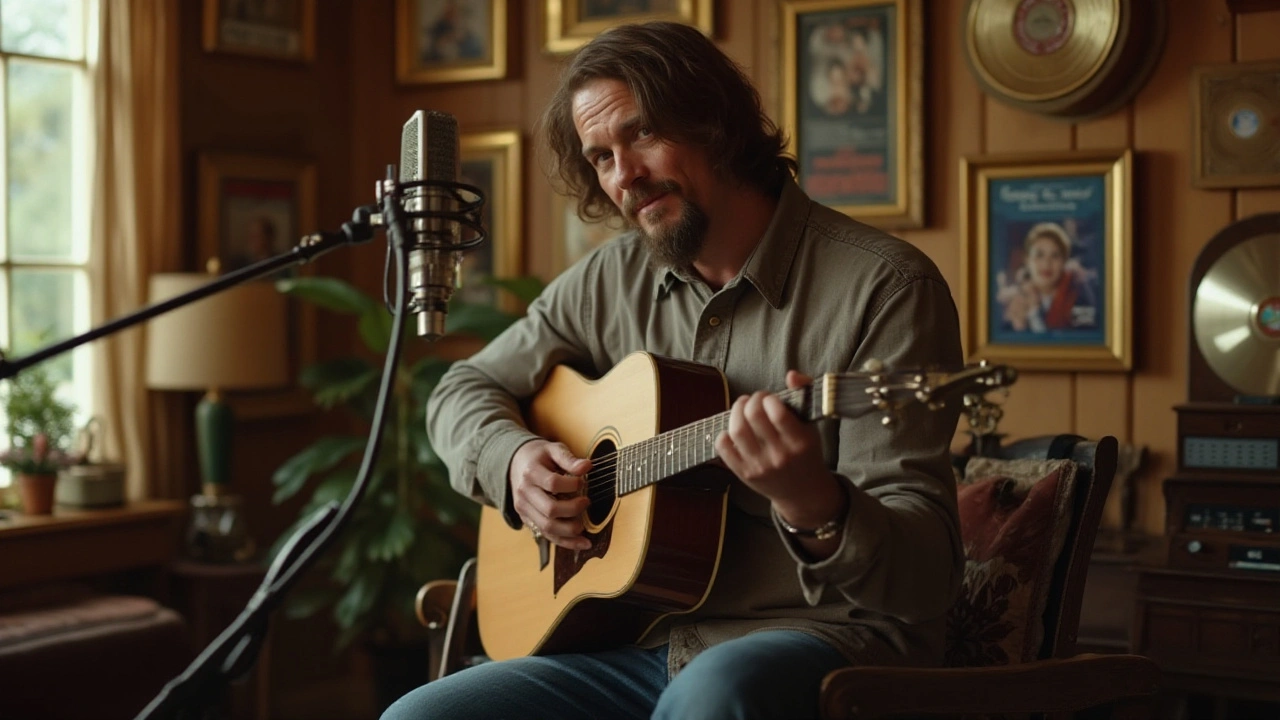Country music has long been a cherished genre, known for its storytelling and emotive lyrics. It's no surprise, then, that it plays a pivotal role in the film industry. From heart-wrenching ballads that underscore emotional scenes to toe-tapping hits that set the mood, country music has found its way into the hearts of moviegoers.
This exploration aims to illuminate the ways in which country music has shaped cinema. We'll trace its historic roots in films, highlight iconic soundtracks that left an indelible mark, and look at how country tunes enhance character development. We'll also discuss notable collaborations between country stars and filmmakers, and their cultural significance.
- History of Country Music in Films
- Iconic Country Soundtracks
- Country Music and Character Development
- Influential Collaborations
- Cultural Impact
- Tips for Using Country Music in Films
History of Country Music in Films
Country music has been entwined with the film industry almost since the advent of sound in cinema. In the 1930s and 40s, Western films emerged as a popular genre, often featuring melodious soundtracks filled with ballads and traditional country tunes. This era saw stars like Gene Autry and Roy Rogers, who were not just cowboys on screen but also accomplished musicians. Their movies often showcased their singing talents and showcased country music to wide audiences.
As the decades rolled on, country music maintained its steady presence in Hollywood. The 1960s and 70s brought forth significant changes, with movies like "Nashville" (1975) providing a deep dive into the intricate world of country music. Directed by Robert Altman, the film featured an ensemble cast and multiple subplots, intertwining personal drama with poignant musical performances. This film highlighted country music's raw emotional impact and brought a more sophisticated narrative to its on-screen representation.
The 1980s saw films like "Urban Cowboy," which starred John Travolta and Debra Winger. The movie played a crucial part in transforming country music's image, making it more appealing to younger, urban audiences. The film's soundtrack included hits by artists like Johnny Lee and the Charlie Daniels Band. These songs catapulted the film to success and made a significant cultural impact.
"‘Urban Cowboy’ did more for country music than a decade of radio play," country artist Johnny Lee once remarked, highlighting the film's influence.
In the 21st century, country music’s relationship with films became even richer and more diverse. Movies like "Walk the Line" (2005), a biopic about Johnny Cash, and "Crazy Heart" (2009) starring Jeff Bridges, showcased the life struggles and triumphs of country musicians. These films brought authenticity and a deeper appreciation for country music's storytelling prowess. Country music provided an emotional soundtrack that resonated deeply with audiences, further solidifying its role in cinematic narrative.
Today, the synergy between country music and films is undeniable. Notable modern films like "A Star is Born" (2018) featuring Bradley Cooper and Lady Gaga have carried this torch forward. The movie’s soundtrack, which included country-style ballads, contributed significantly to the film's emotional depth and its ultimate success at award ceremonies. This illustrates how country music continues to be an essential tool for filmmakers in crafting compelling and memorable scenes.
A review of history shows that country music is much more than just a genre; it’s an influential force that has continually shaped and enriched the film industry. It has been instrumental in framing narratives, constructing authentic characters, and providing emotional resonance throughout cinematic history. As movies evolve, the harmonious bond between country music and films will undoubtedly continue to thrive.
Iconic Country Soundtracks
Music in films is like the heartbeat of a movie, and when it comes to setting a tone that’s both authentic and touching, few genres do it better than country music. One of the most compelling soundtracks that comes to mind is from the 1992 film, Pure Country. Featuring George Strait, one of the genre's legends, the soundtrack became a defining element of the film. Who could forget the hauntingly beautiful 'I Cross My Heart'? This song not only resonated with country fans but also became an anthem for moviegoers.
Then there's O Brother, Where Art Thou? (2000), a prime example of how country and bluegrass music can elevate a film’s narrative. The film’s soundtrack, produced by T Bone Burnett, is a rich tapestry of haunting melodies and foot-stomping rhythms. Songs like 'Man of Constant Sorrow' by The Soggy Bottom Boys gained immense popularity, with the soundtrack winning the Grammy Award for Album of the Year. It’s a perfect instance of how deeply entwined country music can be with the soul of a story.
Reese Witherspoon’s portrayal of June Carter Cash in Walk the Line (2005) brought to life the love story between Carter and Johnny Cash. The soundtrack, including hits like 'Jackson' and 'Ring of Fire', played a significant role in connecting the audience with the characters' highs and lows. What made it more magical was that both Witherspoon and Joaquin Phoenix did their own singing, making the music even more integral to the film's success.
A more recent example is the film Crazy Heart (2009), starring Jeff Bridges. Bridges plays a down-and-out country singer trying to turn his life around, and the film’s soundtrack is a raw, emotional journey through country and roots music. 'The Weary Kind', written by Ryan Bingham, won an Academy Award for Best Original Song and further cemented the movie’s impact on audiences.
“Music and movies are like a family. They live in each other's pockets,” says music supervisor Randall Poster. This sentiment rings especially true for the close-knit relationship between country music and films.
Interestingly, films not specifically centered on country music often feature iconic country soundtracks. Forrest Gump (1994) captured many eras of American history with its diverse soundtrack, but it also included country classics like 'On the Road Again' by Willie Nelson, adding yet another layer of authenticity to its storytelling.
An often overlooked gem is the soundtrack for The Horse Whisperer (1998), which includes beautiful tracks from artists like Emmylou Harris and George Strait. Each song carefully selected to ensure it hits just the right chord emotionally and thematically.

Country Music and Character Development
Country music has a unique way of reflecting the human experience, making it a powerful tool for character development in films. Its ability to tell rich, emotional stories within a few minutes can create deep connections between the audience and the characters on screen. Filmmakers often use country songs to quickly convey a character's background, aspirations, or current emotional state, without needing lengthy dialogue or exposition.
Take, for example, the iconic film Crazy Heart (2009), which starred Jeff Bridges as a washed-up country singer. The film's soundtrack, featuring songs like "The Weary Kind," played a crucial role in developing the character of Bad Blake. Through the lyrics and melodies, viewers gained insight into his struggles, regrets, and hopes for redemption. The music was so essential to the film's narrative that it earned an Academy Award for Best Original Song.
"Music can name the unnameable and communicate the unknowable." - Leonard Bernstein
Similarly, in the movie Walk the Line (2005), Johnny Cash's music is intricately woven into the storyline, helping to paint a vivid picture of his tumultuous life. Songs like "I Walk the Line" and "Ring of Fire" not only serve as a backdrop but also offer a window into his motivations, fears, and the complexities of his relationships. The use of Cash's music enables the audience to better understand his journey and the factors that shaped him as an artist and a person.
Another notable example is the film O Brother, Where Art Thou? (2000), where the soundtrack is steeped in traditional country, bluegrass, and folk music. The characters' quest is deeply intertwined with the music that accompanies them, adding layers to their personalities and making their journey feel more authentic. The film's success even sparked a renewed interest in these genres, proving the cultural impact that a well-chosen soundtrack can have.
The process of selecting the right country songs for a film often involves close collaboration between directors and music supervisors. They must choose tracks that not only match the mood of the scenes but also resonate with the audience on a deeper level. This careful curation can turn a good film into a great one, as the right music can evoke emotions that visuals alone might not fully capture.
Country music's storytelling quality makes it ideal for character development in genres beyond just dramas or biopics. Even in animated films, such as Toy Story 2 (1999), the song "When She Loved Me" by Sarah McLachlan adds depth to the character of Jessie, the cowgirl doll. The lyrics and melancholic tone convey her sense of abandonment and longing, making her more relatable and adding an emotional layer to the story.
It's clear that country music has a special ability to enhance character development in films. By using songs that speak to universal themes of love, loss, struggle, and joy, filmmakers can create characters that feel more grounded and real. Whether through the ballads of a struggling artist or the nostalgic tunes of a bygone era, the right country music can make a film’s characters more memorable and engaging.
Influential Collaborations
One of the most notable aspects of the relationship between country music and the film industry is the numerous influential collaborations that have taken place over the years. These partnerships have not only enriched the film's narrative but also introduced country artists to a broader audience. Take, for instance, the collaboration between Willie Nelson and the film 'Honeysuckle Rose' (1980). Nelson not only starred in the movie but also contributed significantly to its soundtrack, which included his hit song 'On the Road Again.' This track became an anthem for many and underscored the movie's themes of love, travel, and the complexities of life on the road.
Dolly Parton’s collaboration with the film '9 to 5' (1980) is another stellar example. Parton not only acted in the film but also wrote and performed the movie's title track. The song '9 to 5' quickly rose to the top of the charts and became an iconic anthem for workers everywhere. This collaboration showcased Parton's versatility and brought her musical talent to the forefront of mainstream culture.
In more recent years, The Coen Brothers’ film 'O Brother, Where Art Thou?' (2000) redefined the boundaries of how music and film can intersect. The film's soundtrack, featuring country, bluegrass, and folk musicians, played a crucial role in the movie's storytelling. Produced by T-Bone Burnett, the soundtrack includes performances by Alison Krauss, Emmylou Harris, and Ralph Stanley, to name a few. The album was a massive success, winning the Grammy Award for Album of the Year in 2002, which was a rare feat for a soundtrack album.
“The music in 'O Brother, Where Art Thou?' brought traditional American music to a new audience and created a renewed interest in roots music,” noted T-Bone Burnett in an interview with Rolling Stone.
Reese Witherspoon and Joaquin Phoenix's performances in 'Walk the Line' (2005) also stand out. The film, based on the life of Johnny Cash, required its actors to embody their characters not just through acting but also through singing. Witherspoon and Phoenix underwent extensive vocal training to perform Cash's and June Carter's songs authentically. Their hard work paid off, as both received critical acclaim, and Witherspoon even won the Academy Award for Best Actress.
Another collaboration worth mentioning is Bradley Cooper and Lady Gaga in 'A Star is Born' (2018). While Lady Gaga is primarily known as a pop artist, the film involved several country and folk music elements. Cooper, who directed the film, aimed for a raw and authentic musical experience. The song 'Shallow,' sung by Gaga and Cooper, became a massive hit and won several awards, including the Oscar for Best Original Song.
These influential collaborations underline the dynamic relationship between country music and the film industry. They showcase how the emotional depth and storytelling elements of country music can enhance a film’s narrative and connect with audiences on a deeper level. Whether it's a country legend like Willie Nelson, a versatile artist like Dolly Parton, or a modern pop star like Lady Gaga, these partnerships have left an indelible mark on both the music and film worlds.

Cultural Impact
When it comes to shaping cultural narratives, few genres do it as effectively as country music. Its presence in the film industry has played a crucial role in bridging the gap between rural life and urban experiences. This connection allows for a more profound understanding and appreciation of different lifestyles and values. Country music’s influence extends beyond the screen, embedding itself into the American cultural fabric in ways both subtle and overt.
One compelling example is the film “O Brother, Where Art Thou?” directed by the Coen Brothers. The movie’s soundtrack, filled with bluegrass and country tunes, not only enhanced the film’s storytelling but also sparked a renewed interest in these music genres. Sales for the album soared, with more than eight million copies sold, and it brought previously obscure musicians into the limelight.
Country music helps paint vibrant pictures of community and tradition, reinforcing or challenging existing cultural norms. Films like “Walk the Line,” which tells the story of Johnny Cash, have also played a part in cementing the legacies of country music legends. These stories help shape public perceptions and give audiences a window into the lives that inspired such timeless music.
“Country music evokes a sense of place and belonging that few other genres can match,” said Ken Burns, the filmmaker known for his documentary on country music. “It tells the American story in a unique and compelling way.”
The versatility of country music allows it to traverse various film genres, from drama to comedy, thrillers, and even animated features. This flexibility helps the music resonate with diverse audiences. In Pixar’s “Toy Story 2,” for example, the song “When She Loved Me” by Sarah McLachlan adds emotional depth to a character’s backstory, showcasing how country music can evoke powerful emotions even within animated films.
Data from multiple surveys indicate that movies featuring country music often see a spike in soundtrack sales, showing a symbiotic relationship between the music and film industries. This trend is significant because it highlights how country music can drive not just box office success but also music sales. It’s a mutually beneficial relationship that boosts both industries.
The incorporation of country music into films often also leads to live performances, special events, and music festivals that celebrate both the film and its music. This cross-pollination enhances the movie-watching experience and provides additional revenue streams. A notable example is the annual Stagecoach Festival, which celebrates country music and often features artists who have contributed to film soundtracks.
Tips for Using Country Music in Films
Incorporating country music into a film's soundtrack can elevate the emotional impact and enhance storytelling. Here are some key tips to keep in mind when using country tunes in movies.
1. Start by understanding the narrative and emotional tone of your film. Country music is rich with stories of love, loss, and triumph. These themes can deeply resonate with audiences when aligned with your movie's storyline. Consider using slower ballads for emotional scenes and upbeat tracks for lighter moments.
2. Dive into the history of country music to find classic hits and hidden gems. Songs from legends like Johnny Cash, Willie Nelson, and Dolly Parton have timeless appeal. Combining these with modern country tracks can create a versatile and impactful soundtrack. For instance, the film 'Walk the Line,' which features Johnny Cash's music, used his distinctive style to mirror the raw emotional journey of the protagonist.
3. Collaborate with contemporary country artists to create original songs. This not only adds authenticity but also draws in fans of the artists. Songs written specifically for a film can capture the essence of characters and plot, making the film itself more memorable. An example of this is Lady Gaga and Bradley Cooper's collaboration on 'Shallow' for the movie 'A Star is Born,' which won multiple awards and connected deeply with audiences.
"Music is the strongest form of magic," said Marilyn Manson. This quote aptly sums up how a well-chosen song can transform a scene into a magical moment.
4. Consider the setting of your film. Country music often evokes a sense of place, especially rural or Southern landscapes. If your film is set in such locales, country music can enhance the authenticity and immersive experience. Films like 'O Brother, Where Art Thou?' effectively used bluegrass and country music to complement its Southern setting, creating a cohesive and compelling atmosphere.
5. Balance is key. While it's important to feature country music prominently, ensure it doesn't overshadow the film's dialogue and other sound elements. Test the soundtrack with different audience segments to gauge their reactions and make adjustments accordingly.
6. Leverage licensing opportunities wisely. While it might be tempting to include numerous well-known tracks, securing the rights can be costly. Mixing famous songs with lesser-known or independent artists can manage costs without compromising on quality. This approach also gives emerging artists a platform, potentially discovering new favorite tunes for your audience.
Remember to utilize the power of silence as well. Sometimes, a quiet moment without music can make the following musical cue even more impactful. Use country music to punctuate key emotional beats, ensuring the audience feels the intended impact without being overwhelmed.

